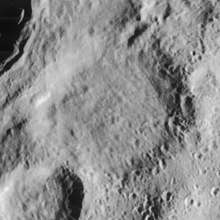Pictet (crater)
Pictet is a lunar impact crater located just to the east of the larger and more prominent impact crater Tycho. The high-albedo rays and ejecta from Tycho lie across Pictet and spread far to the east and in other directions. Pictet is older than Tycho and is somewhat worn by past impacts. The slightly smaller crater Pictet A intrudes slightly into the southwest rim. The larger crater Pictet E is nearly joined to the north rim. To the east is Saussure, and to the northeast is the larger, worn formation Orontius.
 Lunar Orbiter 4 image | |
| Coordinates | 43.6°S 7.4°W |
|---|---|
| Diameter | 62 km |
| Depth | 2.7 km |
| Colongitude | 8° at sunrise |
| Eponym | Marc-Auguste Pictet |
Swiss physicist Marc-Auguste Pictet (eponym of Pictet crater)[1] was the student and later colleague and friend of Horace-Bénédict de Saussure (eponym of nearby Saussure crater).
Satellite craters
By convention these features are identified on lunar maps by placing the letter on the side of the crater midpoint that is closest to Pictet.
| Pictet | Latitude | Longitude | Diameter |
|---|---|---|---|
| A | 45.0° S | 7.9° W | 34 km |
| C | 42.7° S | 7.7° W | 7 km |
| D | 46.0° S | 9.0° W | 21 km |
| E | 41.3° S | 7.7° W | 70 km |
| F | 42.8° S | 6.3° W | 11 km |
| N | 41.5° S | 8.1° W | 7 km |
References
- "Pictet (crater)". Gazetteer of Planetary Nomenclature. USGS Astrogeology Research Program.
- Andersson, L. E.; Whitaker, E. A. (1982). NASA Catalogue of Lunar Nomenclature. NASA RP-1097.CS1 maint: ref=harv (link)
- Bussey, B.; Spudis, P. (2004). The Clementine Atlas of the Moon. New York: Cambridge University Press. ISBN 978-0-521-81528-4.CS1 maint: ref=harv (link)
- Cocks, Elijah E.; Cocks, Josiah C. (1995). Who's Who on the Moon: A Biographical Dictionary of Lunar Nomenclature. Tudor Publishers. ISBN 978-0-936389-27-1.CS1 maint: ref=harv (link)
- McDowell, Jonathan (July 15, 2007). "Lunar Nomenclature". Jonathan's Space Report. Retrieved 2007-10-24.CS1 maint: ref=harv (link)
- Menzel, D. H.; Minnaert, M.; Levin, B.; Dollfus, A.; Bell, B. (1971). "Report on Lunar Nomenclature by the Working Group of Commission 17 of the IAU". Space Science Reviews. 12 (2): 136–186. Bibcode:1971SSRv...12..136M. doi:10.1007/BF00171763.CS1 maint: ref=harv (link)
- Moore, Patrick (2001). On the Moon. Sterling Publishing Co. ISBN 978-0-304-35469-6.CS1 maint: ref=harv (link)
- Price, Fred W. (1988). The Moon Observer's Handbook. Cambridge University Press. ISBN 978-0-521-33500-3.CS1 maint: ref=harv (link)
- Rükl, Antonín (1990). Atlas of the Moon. Kalmbach Books. ISBN 978-0-913135-17-4.CS1 maint: ref=harv (link)
- Webb, Rev. T. W. (1962). Celestial Objects for Common Telescopes (6th revised ed.). Dover. ISBN 978-0-486-20917-3.CS1 maint: ref=harv (link)
- Whitaker, Ewen A. (1999). Mapping and Naming the Moon. Cambridge University Press. ISBN 978-0-521-62248-6.CS1 maint: ref=harv (link)
- Wlasuk, Peter T. (2000). Observing the Moon. Springer. ISBN 978-1-85233-193-1.CS1 maint: ref=harv (link)
| Wikimedia Commons has media related to Pictet (crater). |